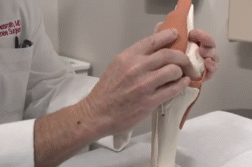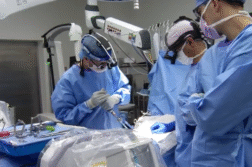Dr. Xavier Simcock, Hand & Upper Extremity Surgeon at Midwest Orthopedics at Rush, talks about saving the almost-amputated arm of a Ukrainian soldier.
Interview conducted by Ivanhoe Broadcast News in 2023.
How did you meet Andrii?
Simcock: I met Andrii as a referral through the church. Fortunatly, they got in touch with one of my partners and we heard about his story. We were interested to try and help.
When you met him, what were your thoughts?
Simcock: Well, our thoughts were overwhelming. It’s rare that we get to manage blast injuries in this country because fortunately, we don’t have a lot of blast injuries. It was a unique opportunity to help because there’s a huge conflict going on with a lot of humanitarian needs. That’s what we do in medicine, we try and help out where we can. This was a really nice opportunity to be able to help people that needed care. Andrii, in specific, had a devastating wound and one that we commonly treat, but many times those opportunities aren’t available in underdeveloped areas in nations in conflict.
How dire was his situation?
Simcock: It was a unique situation. He had an open fracture so when the bone gets infected, the problem is, it can stay infected for years and years. That can lead to terrible situations where you have to amputate the arm and do other things. With Andrii, he had an infection, it was still an open wound and needed coverage over the bone, and he had a fracture that was devastating to the elbow. Also, he had multiple nerve injuries as well, so we had to put all those pieces together.
Did you think you could save his limb or were you doubtful?
Simcock: Well, it all depends on the infection. When we got to him it had already been two months since the injury; and even though he’d been stabilized, there was still a chronic infection. The worry is can we fix it? Luckily, he’s a young man, and so we had everything going in his favor. We thought we’d throw the kitchen sink at it.
What were the first steps?
Simcock: The first step was to clear the infection. He had a huge area that was opened on the outside of his elbow. We took our time in making sure to get rid of everything that could potentially continue to be bad for him. We then used a combination of antibiotics, as well as IV antibiotics, in the wound site to help us stabilize the elbow and ensure there was an adequate amount of healing. At that point, we were then able to move muscle around. We were prepared to potentially take one of his muscles from his back to try and cover the wound. Fortunately, we didn’t need to. We could localize rotationally some muscles directly over the lateral aspect, that got him enough coverage. We then stabilized the elbow by fusing it. It’s not fun losing motion in your elbow, but it’s better to have a hand that’s functional that you can use. That was the goal of the treatment.
For clarity, you connected his upper arm bone to his lower arm bone through the process of fusion. But unfortunately, his wound was so severe his elbow detached from his body?
Simcock: The degree of difficulty was the open wound and the blast injury that had taken out his elbow. Therefore the goal was to get rid of the infection, but to then connect the rest of his arm through fusion from the upper arm to the lower arm. That way he still had a hand that he could use in space and function as opposed to losing the complete use of his arm.
How has his progress been? Are you pleased?
Simcock: We have been very pleased with Andrii. It’s been a long process, and he’s been very patient with us. The longest part of any process with an injury like this is the nerve recovery. It can easily take up to two years to see improvement in that area, but fortunately we’ve already seen signs of good active recruitment of muscle function. He’s slowly coming to a place where he’s much more functional with his arm.
In Andrii’s case it seems you’ve really gone the extra mile. You’re not just helping in the O.R., you’ve also been contacting the State Department. Can you explain what the process post surgery has been for Andrii?
Simcock: Simplistically, you can think about surgery as a onetime event where you get to fix something and move on. But the reality is healing takes much longer. We’ve been working with his community and his church to make sure he’s been taken care of appropriately. We’ve also reached out to the State Department (since he’s under an immigration status right now) to ensure he’s kept here for the duration of his care.
How long will he need your care?
Simcock: Typical recovery is all dependent on the nerve. Fortunately for Andrii he’s displayed good signs already. It’s been close to a year since he’s been in my care, but hopefully his treatment may be as short as 18 months. If not, it may two years.
Why did you pursue Andrii? Putting your profession aside, how does this make you feel as a human?
Simcock: Honestly, this is why you become a doctor. You get to take situations where people are overwhelmed by an injury and you can bring them back to a functional place. This is one of those unique times where I get to put all of these fun skills that I’ve learned over an incredible amount of time to good use. It’s a very gratifying thing to be able to do.
What are your hopes for Andrii?
Simcock: Well, according to him, he wants to go back and actually participate in the war. If that’s the case, then I hope that he gets what his wishes are. My hopes for him is that he gets to be the young man that he is. That he’ll live a functional life and use his arm to his full degree.
END OF INTERVIEW
This information is intended for additional research purposes only. It is not to be used as a prescription or advice from Ivanhoe Broadcast News, Inc. or any medical professional interviewed. Ivanhoe Broadcast News, Inc. assumes no responsibility for the depth or accuracy of physician statements. Procedures or medicines apply to different people and medical factors; always consult your physician on medical matters.
If you would like more information, please contact:
Ann Pitcher
Sign up for a free weekly e-mail on Medical Breakthroughs called First to Know by clicking here




